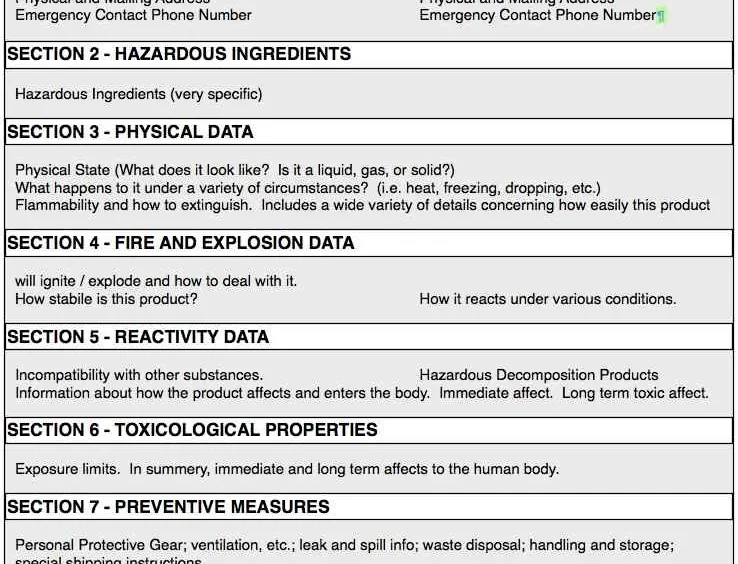Whether you’re cleaning the engine room with a degreaser or loading bunkers on deck, there’s one thing you must check before handling any chemical – the MSDS, also known as the Material Safety Data Sheet.
This is not just paperwork. It’s your first line of defence against injury, accidents, and chemical exposure. Sadly, many cadets and junior officers ignore it, thinking it’s only for the Chief Officer or Safety Officer. But actually, every crew member should know how to use an MSDS properly.
Let’s break it down.
What is MSDS?
MSDS stands for Material Safety Data Sheet.
It is a document that gives complete information about a chemical, including how to store, handle, use, and dispose of it safely.
It also tells you what to do in case of spillage, inhalation, skin contact, or fire.
Every chemical on board – from cleaning agents to paint thinners, even simple things like alcohol wipes – must have an MSDS copy onboard.
Where Can You Find the MSDS Onboard?
In the Safety File on the bridge or CCR
With the Chief Officer or Safety Officer
Posted near chemical lockers, garbage rooms, or paint rooms
Often, a copy is available in the E/R control room or cargo control room
Sometimes available in digital format on ship’s computer systems or intranet
Tip: During inspections, PSCO or RightShip inspector may randomly ask to show MSDS for any chemical lying around. Be prepared.
Why is MSDS So Important?
Because not all chemicals are harmless.
Some are flammable. Some are poisonous. Some burn your eyes or skin. And some can even release toxic gases if mixed with other substances.
MSDS helps you:
Know what PPE to wear while handling the product
Understand first aid measures in case of exposure
Follow safe storage guidelines (e.g., keep away from heat/sunlight)
Learn how to clean up spills or leakages safely
Know the chemical’s effect on marine environment (important for MARPOL compliance)
How to Read an MSDS (Don’t Just Pretend)
A standard MSDS usually has 16 sections. You don’t have to memorize them all, but you must know the following key ones:
1. Product Identification – Name, supplier, emergency contact
2. Hazards Identification – What risks are involved
3. Composition – What’s inside the chemical
4. First Aid Measures – What to do in case of contact/inhalation
5. Fire-Fighting Measures – What type of extinguisher to use
6. Accidental Release Measures – Spill clean-up method
7. Handling & Storage – Safe practices and storage conditions
8. Exposure Controls / PPE – What protection to use (goggles, gloves, masks)
9. Disposal Considerations – How to discard the product safely
10. Regulatory Information – Relevant international codes/standards
Examples You Must Know Onboard
Degreaser in engine room – flammable, causes skin burns – requires gloves and eye protection
Hydrochloric acid in paint locker – dangerous fumes, use in ventilated area only
Bunker sample bottles – some chemicals inside are carcinogenic – avoid contact
Oxy-acetylene gases – MSDS explains handling and explosion risks
Even ordinary bleach can cause toxic gas if mixed with other cleaning products!
For Cadets and Junior Officers
Before using any chemical, read the MSDS first – it’s your right and duty
Record MSDS awareness and handling in your Training Record Book (TRB)
During drills or safety meetings, volunteer to explain an MSDS – it shows you’re serious
If in doubt, ask the Chief Officer or Bosun – don’t pretend to know
When preparing Risk Assessments or PTW, always attach MSDS copy
Questions They Can Ask in Orals/Interviews
1. What is MSDS and why is it used onboard ships?
2. Where can you find MSDS?
3. What PPE is required to handle a specific chemical (e.g. MEK or Acetone)?
4. What steps to take if a chemical spills on deck?
5. How does MSDS help in environmental protection?
Last Words – Don’t Wait for an Accident to Learn
A true seafarer doesn’t fear chemicals, but respects them. You may not be a chemical engineer, but basic awareness is essential. MSDS is there to protect you, not trouble you.
So, next time you pick up a can of paint, a spray bottle, or a degreaser – don’t just look at the label. Look for the MSDS too.
Because safety doesn’t start with helmets and gloves. It starts with knowledge.
Stay safe. Stay aware.


